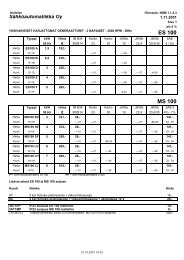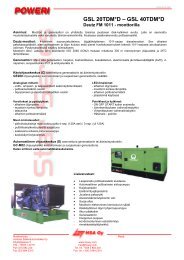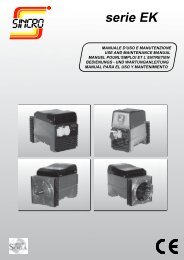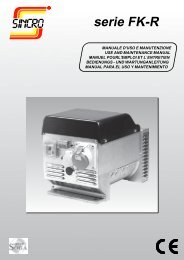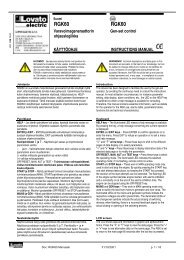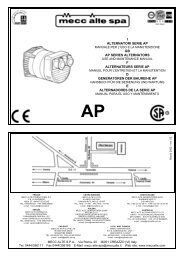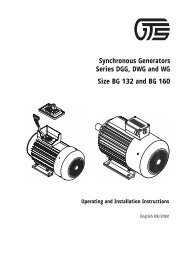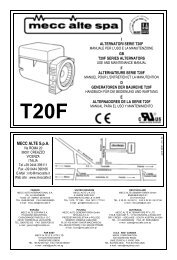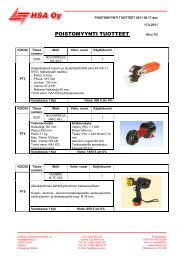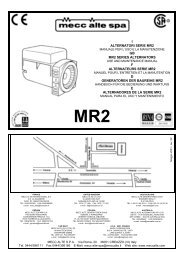Create successful ePaper yourself
Turn your PDF publications into a flip-book with our unique Google optimized e-Paper software.
ACCOPPIAMENTO<br />
ELETTRICO<br />
IMPORTANTE :<br />
il controllo di tensione va eseguito a vuoto con<br />
l’alternatore funzionante a frequenza nominale.<br />
Agendo sul potenziometro tensione dei regolatori<br />
elettronici si puo’ ottenere la regolazione<br />
della tensione entro il ± 5% del valore<br />
nominale.<br />
E' possibile ottenere la regolazione della tensione<br />
a distanza in un range di ± 5% inserendo<br />
negli appositi morsetti un potenziometro<br />
da 100K (per le macchine a 6 morsetti) o un<br />
potenziometro da 100K con in serie una resistenza<br />
da 100K (per le macchine a 12 morsetti).<br />
Istruzioni per il collegamento del potenziometro<br />
esterno :<br />
ATTENZIONE : quando si collega il potenziometro<br />
esterno è necessario seguire la procedura<br />
sottoriportata per ottenere un corretto<br />
funzionamento dell'alternatore.<br />
1) Ruotare il trimmer VOLT nel regolatore<br />
elettronico completamente in senso antiorario<br />
2) Posizionare il potenziometro esterno a meta'<br />
corsa e connetterlo agli appositi morsetti del<br />
regolatore elettronico<br />
3) Tramite il trimmer VOLT del regolatore elettronico<br />
tarare la tensione al valore nominale.<br />
PROTEZIONI<br />
U.V.R.6/1-F - S.R.7/2-G<br />
Entrambi i regolatori sono provvisti di una protezione<br />
di bassa velocita’ la cui soglia di intervento<br />
e’ regolabile tramite il potenziometro<br />
“Hz”. L’intervento di tale protezione e’ istantaneo<br />
riducendo la tensione di macchina<br />
quando la frequenza scende sotto il 10% di<br />
quella nominale. I regolatori prevedono anche<br />
una seconda protezione (protezione di sovraccarico),<br />
che sente la tensione parzializzata<br />
che va al campo di statore dell’eccitatrice<br />
e se essa supera per piu’ di 20 sec il valore<br />
stabilito, abbassa la tensione di macchina limitando<br />
la corrente di eccitazione entro valori di<br />
sicurezza.<br />
Il ritardo appositamente inserito consente lo<br />
spunto del motore che normalmente si avvia<br />
in 5 - 10 sec. Anche la soglia di intervento di<br />
questa protezione e’ regolabile tramite il potenziometro<br />
“AMP”.<br />
U.V.R.6/1-F<br />
Il regolatore U.V.R.6/1-F aggiunge alle prestazioni<br />
prima descritte, le seguenti caratteristiche:<br />
1 - possibilita’ di avere il riferimento trifase oltre<br />
che monofase.<br />
2 - segnalazioni a led di autodiagnostica che<br />
indicano le condizioni di funzionamento della<br />
macchina: un led verde, che normalmente<br />
acceso indica il funzionamento normale del<br />
generatore; un led rosso che indica l’intervento<br />
della protezione di bassa velocita’, un<br />
led giallo che indica l’intervento della protezione<br />
di sovraccarico.<br />
24<br />
ELECTRICAL<br />
CONNECTIONS<br />
IMPORTANT :<br />
the generator output voltage must be checked<br />
under no-load conditions, with the correct setting<br />
of frequency.<br />
The voltage may be adjusted by ± 5% of the<br />
nominal, by acting upon the voltage potenziometer<br />
on the electronic regulators.<br />
It is possible to get a remote voltage regulation<br />
of ± 5% inserting in the proper terminals a<br />
100K potentiometer (for the 6 lead units) or a<br />
100K potentiometer with a 100K resistance in<br />
series (for the 12 lead units).<br />
Instructions to follow for the external potentiometer<br />
connection:<br />
CAUTION: in order to get a correct working of<br />
the alternator, it is necessary to follow the following<br />
procedure, connecting the external potentiometer.<br />
1) Turn the VOLT trimmer of the electronic<br />
regulator completely anticlockwise.<br />
2) Set the external potentiometer at half turn<br />
and connect it to the proper terminals of the<br />
electronic regulator.<br />
3) Adjust the voltage at the nominal value by<br />
the VOLT trimmer of the electronic regulator.<br />
PROTECTIONS<br />
U.V.R.6/1-F - S.R.7/2-G<br />
Both regulators are provided with an underspeed<br />
protection with an intervention threshold<br />
which can be adjusted by the potentiometer<br />
marked “Hz”. This protection intervenes instantaneously<br />
by reducing the alternator voltage<br />
to a safe value when frequency falls below<br />
10% of the nominal value. These regulators<br />
also have inherent overload protection<br />
which senses the exciter field voltage value.<br />
Should this field voltage value exceed the nominal<br />
value for a period of more than 20 seconds,<br />
then again the alternator voltage is<br />
automatically reduced to a safe operating level.<br />
This overload function has a built-in delay<br />
to allow for the overload when starting motors<br />
(normally 5-10 seconds). The operating threshold<br />
of this protection device is adjustable by<br />
the potentiometer marked “AMP”.<br />
U.V.R.6/1-F<br />
Aside from the above mentioned characteristics,<br />
the U.V.R.6/1-F regulator also offers<br />
the following:<br />
1 - possibility to have single-phase as well as<br />
three-phase sensing<br />
2 - led indicators for self-diagnosis which indicate<br />
the unit’s operational conditions: a green<br />
led which when lit confirms the alternator’s<br />
normal functioning; a red led indicates the underspeed<br />
protection is on; a yellow led indicates<br />
the overload protection is on.<br />
<strong>ECO</strong>-<strong>ECP</strong> MANUAL SEPT. 2005 REVISION 16



